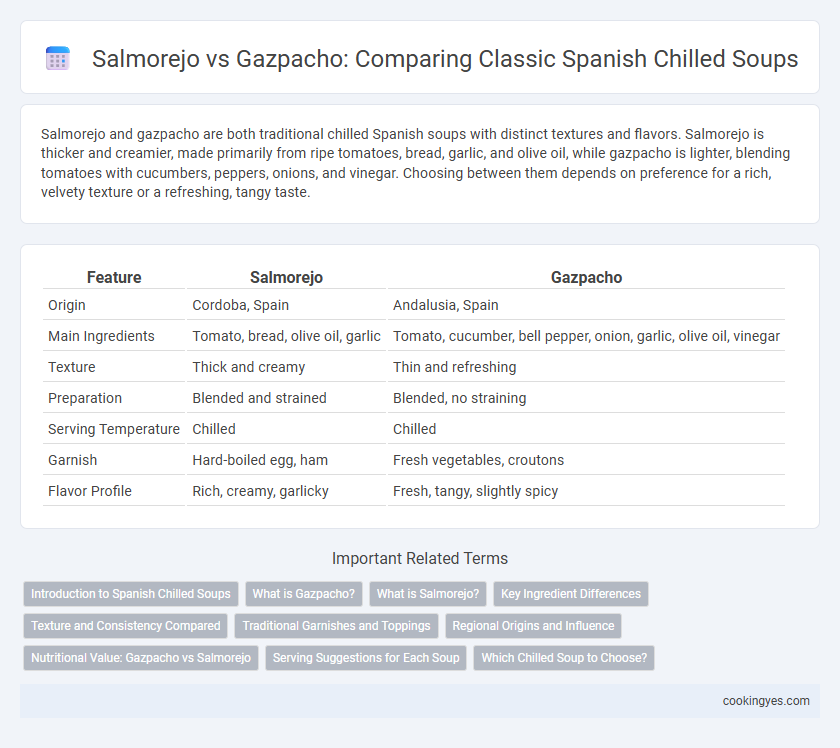Salmorejo and gazpacho are both traditional chilled Spanish soups with distinct textures and flavors. Salmorejo is thicker and creamier, made primarily from ripe tomatoes, bread, garlic, and olive oil, while gazpacho is lighter, blending tomatoes with cucumbers, peppers, onions, and vinegar. Choosing between them depends on preference for a rich, velvety texture or a refreshing, tangy taste.
Table of Comparison
| Feature | Salmorejo | Gazpacho |
|---|---|---|
| Origin | Cordoba, Spain | Andalusia, Spain |
| Main Ingredients | Tomato, bread, olive oil, garlic | Tomato, cucumber, bell pepper, onion, garlic, olive oil, vinegar |
| Texture | Thick and creamy | Thin and refreshing |
| Preparation | Blended and strained | Blended, no straining |
| Serving Temperature | Chilled | Chilled |
| Garnish | Hard-boiled egg, ham | Fresh vegetables, croutons |
| Flavor Profile | Rich, creamy, garlicky | Fresh, tangy, slightly spicy |
Introduction to Spanish Chilled Soups
Salmorejo and gazpacho are iconic Spanish chilled soups known for their refreshing qualities during warm weather. Salmorejo features a thicker, creamier texture made primarily from tomatoes, bread, garlic, olive oil, and vinegar, while gazpacho offers a lighter, more liquid consistency with additional vegetables like cucumbers, peppers, and onions. Both soups showcase Spain's tradition of using fresh, high-quality ingredients to create nutritious and flavorful cold starters.
What is Gazpacho?
Gazpacho is a traditional Andalusian chilled Spanish soup made primarily from ripe tomatoes, cucumbers, bell peppers, garlic, olive oil, vinegar, and stale bread, all blended into a smooth, refreshing dish. Unlike Salmorejo, which is thicker and creamier due to a higher bread and tomato ratio, Gazpacho features a lighter consistency with more vegetable content for a crisp, vibrant flavor. Often served cold in the summer, Gazpacho showcases Mediterranean ingredients and highlights the use of fresh, seasonal produce.
What is Salmorejo?
Salmorejo is a traditional Andalusian cold Spanish soup made from ripe tomatoes, bread, garlic, olive oil, and vinegar, blended into a thick, creamy texture. Unlike gazpacho, salmorejo uses stale bread to create a richer, denser consistency and is typically garnished with hard-boiled eggs and serrano ham. This dish highlights the simplicity and intense flavors of fresh Mediterranean ingredients, making it a popular chilled soup during hot summers.
Key Ingredient Differences
Salmorejo uses more bread and tomatoes, resulting in a thicker, creamier texture, while gazpacho contains a higher proportion of cucumber, bell pepper, and garlic for a lighter, more refreshing flavor. The key ingredient in salmorejo is stale white bread, which acts as a thickening agent, whereas gazpacho relies on a medley of fresh vegetables and olive oil to achieve its consistency. Both soups highlight the distinct regional preferences in Andalusian cuisine, with salmorejo offering richness and gazpacho emphasizing crisp, vibrant freshness.
Texture and Consistency Compared
Salmorejo features a thicker, creamier texture due to its higher concentration of blended tomatoes and bread, creating a velvety consistency that is richer than Gazpacho. Gazpacho offers a lighter, more liquid consistency with a chunkier texture often including diced vegetables like cucumber and bell pepper. The contrasting textures make Salmorejo ideal for a smooth, dense chilled soup experience, while Gazpacho provides a refreshing, crisp mouthfeel with varied vegetable pieces.
Traditional Garnishes and Toppings
Salmorejo traditionally features toppings like hard-boiled eggs, diced Spanish ham (jamon serrano), and drizzles of olive oil that enhance its creamy tomato base. Gazpacho is usually garnished with chopped cucumbers, green peppers, onions, and croutons, emphasizing its lighter, more refreshing texture. Both chilled Spanish soups showcase distinct regional garnishes that reflect their unique preparation and flavor profiles.
Regional Origins and Influence
Salmorejo and gazpacho both originate from southern Spain, with salmorejo rooted in Cordoba and gazpacho associated mainly with Andalusia, particularly Seville. Salmorejo's creamy texture stems from a higher concentration of tomatoes and bread, reflecting Cordoba's culinary preference for richer, thicker soups. Gazpacho's lighter, more liquid consistency and inclusion of cucumbers and peppers highlight the coastal and agricultural influences prevalent in Andalusian cuisine.
Nutritional Value: Gazpacho vs Salmorejo
Gazpacho offers a lighter nutritional profile with lower calories and fat, mainly due to its base of fresh vegetables like tomatoes, cucumbers, and peppers, making it rich in vitamins A and C. Salmorejo, thicker and creamier, contains higher calories and fat because of added bread and olive oil, contributing to increased carbohydrates and monounsaturated fats. Both soups provide antioxidants but differ in macronutrient density, with gazpacho favoring hydration and vitamins, while salmorejo emphasizes energy and healthy fats.
Serving Suggestions for Each Soup
Salmorejo is traditionally served thick, topped with diced hard-boiled eggs, jamon serrano, and a drizzle of olive oil, enhancing its creamy texture and rich flavor profile. Gazpacho is served cold with a thinner consistency, often garnished with finely chopped vegetables like cucumber, tomato, bell pepper, and croutons for added crunch and freshness. Both soups highlight the use of ripe tomatoes but differ in presentation, with Salmorejo emphasizing a more indulgent, appetizer-style serving and Gazpacho offering a lighter, refreshing option ideal for hot weather.
Which Chilled Soup to Choose?
Salmorejo and gazpacho are both traditional chilled Spanish soups but differ in texture and ingredients, making the choice dependent on personal preference and occasion. Salmorejo is thicker and creamier, primarily made with ripe tomatoes, bread, garlic, and olive oil, offering a rich, smooth consistency ideal for a hearty appetizer. Gazpacho features a lighter, more refreshing blend with blended raw vegetables such as cucumbers, peppers, onions, and tomatoes, perfect for a cooling, hydrating summer dish.
Salmorejo vs Gazpacho for chilled Spanish soups Infographic

 cookingyes.com
cookingyes.com